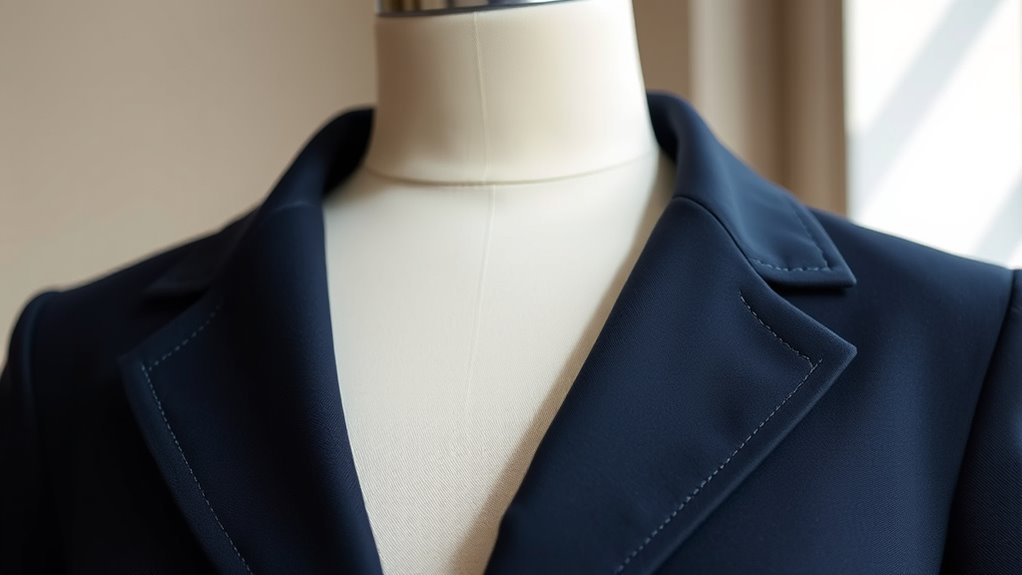Great fit transforms your outfit from ordinary to polished. It’s more important than brand or price because well-fitting clothes boost confidence, enhance your features, and create a balanced silhouette. Tailoring ensures your clothes follow your natural shape, making everything look intentional. Small adjustments can turn an average piece into a perfect fit. Want to learn how specific fit areas and expert tailoring can make all the difference? Keep exploring to reveal the secret to style confidence.
Key Takeaways
- Proper fit enhances confidence and makes outfits look polished, regardless of brand or price.
- Tailoring corrects common fit issues, like shoulder alignment and waist contouring, improving overall appearance.
- Well-fitted clothing accentuates your best features and creates a balanced, harmonious silhouette.
- Customized tailoring reduces the need for frequent wardrobe updates and costly alterations.
- Attention to fit communicates style awareness and professionalism, making a strong, positive impression.
Why Fit Matters More Than Brand or Price

While brand and price can influence your initial choice, the way a garment fits is what truly determines your comfort and confidence. A well-fitting piece feels natural and allows you to move freely without constantly adjusting or feeling restricted. No matter how expensive or trendy a garment is, if it doesn’t fit properly, it can ruin your entire look and make you feel self-conscious. Proper fit highlights your best features and minimizes any areas you might want to downplay. It also boosts your confidence because you know your clothes are flattering and comfortable. Investing in clothing that fits well is a key aspect of personal finance, as it reduces the need for constant wardrobe updates and alterations. Additionally, automation in tailoring and fitting services is making it easier to find clothes that fit perfectly without the need for extensive modifications. The use of advanced sizing technology is revolutionizing how consumers find well-fitting clothes, making fit more accessible. Innovations like custom clothing options are further enhancing the ability to achieve a perfect fit. Furthermore, professional fitting services are increasingly available, providing personalized adjustments that improve overall satisfaction. Ultimately, investing in clothing that fits well pays off far more than chasing after the latest brands or the highest price tags. Fit is the foundation of a polished, put-together appearance.
The Impact of Tailoring on Your Overall Look

When you have your clothes tailored, they better suit your body’s proportions, making you look more balanced and polished. This small change can instantly boost your style confidence, helping you feel more assertive in your appearance. Proper fitting garments can also reduce the need for multiple outfit changes, saving you time and money in the long run. Incorporating customized clothing options can further elevate your overall style and ensure a perfect fit. Additionally, paying attention to space and organization in your wardrobe can make tailoring and selecting outfits more efficient, leading to a more streamlined dressing process. Understanding cost-effective tailoring options can help you make better wardrobe investments while maintaining style. Ultimately, tailoring transforms your overall look into one that’s both flattering and effortlessly stylish. Additionally, incorporating personalized accessories like Alzheimer bracelets can enhance your outfit while providing safety and peace of mind.
Enhances Body Proportions
Tailoring has a powerful effect on your body proportions, making your overall look more balanced and polished. When clothes fit properly, they accentuate your best features and create a harmonious silhouette. For example, tailoring can make your waist appear narrower, elongate your legs, or lift your shoulders. It smooths out excess fabric that can distort proportions, helping you avoid a baggy or bulky appearance. Adjustments like darting, taking in the sides, or shortening sleeves ensure each piece complements your unique shape. This precision enhances your natural lines, giving you a more proportionate and confident look. Properly tailored clothing doesn’t just fit; it reshapes how your body is perceived, emphasizing your strengths and creating a streamlined, cohesive appearance. Using tailoring techniques can further refine your overall silhouette and ensure your clothing complements your body perfectly. Additionally, paying attention to fabric choices can influence how well clothing conforms to your body, contributing to a tailored fit. Being aware of body proportions and how clothing interacts with them allows for even more effective tailoring outcomes.
Elevates Style Confidence
Properly tailored clothing instantly boosts your style confidence by ensuring you look polished and put-together. When your clothes fit perfectly, you feel more assured in your appearance, which naturally enhances how you carry yourself. Tailoring removes distractions like baggy sleeves or ill-fitting waistlines, allowing your best features to shine. This attention to detail communicates that you care about your presentation, making a strong impression. As a result, you’ll find yourself more comfortable in social and professional settings. When your outfit fits well, you won’t second-guess your look or worry about wardrobe malfunctions. Instead, you’ll exude self-assurance, making your overall presence more compelling. Additionally, color accuracy plays a significant role in how polished and professional your outfit appears, especially in settings where visual impression is key. In short, tailoring transforms your outfit from ordinary to extraordinary, elevating your confidence effortlessly.
Common Fit Issues and How to Correct Them

Fit issues are common, but they’re often easy to fix with the right adjustments. Poor fit can make even the best outfit look off, but small tweaks can dramatically improve your look. For example, if your shirt pulls at the shoulders, it might be too tight or long. If your trousers bunch at the waist, they need a better fit or a belt. Excess fabric around the hips or chest can be taken in for a cleaner silhouette. Here are some common issues and solutions:
- Sleeves too long or short: get them hemmed or tailored
- Waist too loose or tight: add darts or take in the fabric
- Pants bunching at the crotch: adjust the rise or fit
- Excess fabric in the back: taper the sides or add darts
- Collars or cuffs not laying flat: re-press or resize for better fit
A good understanding of body proportions can also help in choosing and tailoring clothing for a more flattering fit. Additionally, knowing emotional support strategies can assist in building confidence when trying new styles or fits.
Key Areas to Focus on for a Flawless Fit

To achieve a flawless fit, focus on proper shoulder alignment to guarantee your garment sits naturally and comfortably. Accurate waist contouring is also essential to highlight your shape without restricting movement. Paying attention to these key areas makes a noticeable difference in how your clothing looks and feels. Additionally, understanding how trust issues can impact your relationship dynamics allows for better communication and a more tailored approach to personal style. Recognizing the influence of sneaker culture can also help in selecting footwear that complements your overall look and confidence. Being aware of AI and Content Creation tools can further assist in personal styling inspiration and fashion advice, just as tailored grooming and personalized care routines are vital for dogs with unique needs to maintain their health and happiness. Incorporating solar energy solutions into your wardrobe choices might sound unconventional, but sustainable fashion options are increasingly shaping the industry.
Proper Shoulder Alignment
When evaluating shoulder alignment, focus on guaranteeing the shoulders sit evenly and naturally without any forward slant or drooping. Proper shoulder placement creates a balanced silhouette and enhances comfort. Check that the shoulder seams align with the natural edge of your shoulders; they shouldn’t droop or pull forward. Look for symmetry between both shoulders to avoid uneven weight distribution. Ensure the fabric around the shoulders lies flat without puckering or stretching. Adjust the fit if you notice any of these issues:
- Shoulders slope unnaturally or appear uneven
- Seams don’t align with shoulder edges
- Fabric pulls or puckers at the shoulder line
- Shoulders appear forward-slanted or drooped
- Movement feels restricted or uncomfortable
Getting this right helps your outfit look sharp and feel comfortable. Maintaining proper shoulder alignment also contributes to overall garment vitality and durability, ensuring the fit remains consistent over time. Additionally, understanding the importance of essential oils for shoulder relief can aid in relaxing shoulder muscles and improving posture during fitting adjustments. Incorporating proper fitting techniques can further enhance the accuracy of shoulder alignment and overall garment quality. Being aware of sleeper position can also help in preventing postural issues that affect shoulder alignment over time. Moreover, considering car seat ergonomics can help maintain proper posture, reducing strain on the shoulders during long periods of sitting.
Accurate Waist Contouring
Achieving accurate waist contouring is essential for a polished and comfortable look. Your waistline is the natural focal point, so tailoring should highlight your curves without creating bulges or gaps. To do this, guarantee the waistband fits snugly but not tightly, following your natural waist shape. Avoid excess fabric that bunches or causes sagging, and make sure the garment contours smoothly around your midsection. Precise pinning and careful measurements help prevent distortion and emphasize your silhouette. Incorporating high-tech tailoring techniques can further improve fit and comfort. Additionally, understanding body proportions allows for more precise adjustments that enhance overall harmony. Whether working with skirts, trousers, or dresses, the goal is to create a seamless shift from your waist to the rest of the outfit. When your waist is perfectly contoured, it enhances your overall proportion and boosts your confidence.
Tips for Working Effectively With a Tailor

Working effectively with a tailor starts with clear communication. Be specific about what you want, and don’t hesitate to ask questions. Bring reference images or notes to clarify your vision. Trust your tailor’s expertise, but also voice your concerns if something doesn’t feel right. Establish a timeline so you know when to expect updates or fittings. Be honest during fittings—point out issues immediately. Respect their professional advice on fabric or style adjustments. Keep an open mind to suggestions that might improve the fit or look. Ultimately, maintain a friendly, collaborative attitude to make the process smooth.
- Clearly articulate your expectations
- Bring visual references or notes
- Trust and respect your tailor’s expertise
- Communicate openly during fittings
- Follow agreed timelines and give feedback
Maintaining Your Clothes for Long-Lasting Fit

To keep your clothes fitting perfectly over time, regular maintenance is essential. Proper care prevents stretching, shrinking, and wear that can ruin a tailored look. Always follow washing instructions—hand wash or dry clean when needed. Store clothes properly, hanging suits and folding knits neatly. Spot clean stains promptly to avoid permanent damage. Additionally, check for loose threads or buttons and fix them immediately. Here’s a quick guide to maintenance:
| Care Tip | Why It Matters |
|---|---|
| Hand wash or dry clean | Preserves fabric integrity |
| Store properly | Maintains shape and prevents wrinkles |
| Spot clean stains | Keeps clothes looking fresh |
| Repair promptly | Prevents further damage |
| Avoid over-washing | Extends the lifespan of your clothes |
Frequently Asked Questions
How Often Should I Get My Clothes Tailored?
You should get your clothes tailored whenever they no longer fit perfectly or after significant weight changes. Typically, fine-tune your wardrobe once or twice a year to maintain a sharp look. For special occasions or new purchases, consider tailoring immediately to ensure a flawless fit. Regular tailoring keeps your clothes looking polished and comfortable, boosting your confidence and style effortlessly. Don’t wait too long—fit is key to making any outfit stand out.
Can Tailoring Fix All Fit Issues?
Think of your clothes as a garden needing careful pruning. While tailoring can fix many issues—like hemming pants or taking in a waist—it’s not a magic wand for every flaw. Some fit problems, such as fabric that’s too tight or poorly constructed pieces, can’t be transformed into perfection. You’ll get the best results when you start with well-made garments and trust skilled tailors to refine the fit.
What Are Signs My Clothes Need Adjusting?
You’ll notice your clothes need adjusting when they feel too tight or loose, or if they bunch or sag in certain areas. If sleeves are too long, shoulders don’t sit right, or hemlines are uneven, it’s a sign for tailoring. Sometimes, you’ll see gap at the buttons or the fabric pulls. Trust your comfort and look for these cues to determine when adjustments will make your outfit fit perfectly.
How Do I Communicate My Preferences to a Tailor?
When you want to communicate your preferences to a tailor, be clear and specific. Show them the items you’re customizing and point out what you like or dislike, whether it’s the fit, length, or style. Use your words, but also rely on examples or photos if possible. Don’t hesitate to ask questions and confirm details to make sure they understand exactly what you want. This way, your clothes will fit perfectly.
Does Tailoring Affect the Durability of My Clothing?
Sure, tailoring might seem like a magic fix, but it doesn’t magically extend your clothes’ lifespan. In fact, a well-done tailoring can reinforce seams and improve fit, preventing unnecessary wear and tear. So, instead of worrying about durability, focus on quality fabrics and proper care. You’ll get more mileage out of your wardrobe, and your tailor’s work will help your clothes last longer, not shorter.
Conclusion
Think of your wardrobe as a finely tuned instrument; even the smallest adjustments can turn a good outfit into a masterpiece. When you prioritize fit and work with skilled tailors, you’re not just dressing up—you’re creating a harmony that boosts your confidence and style. Don’t let ill-fitting clothes be static noise. Instead, tune your wardrobe to perfection, and watch how your look transforms into a symphony of style that truly speaks for you.










